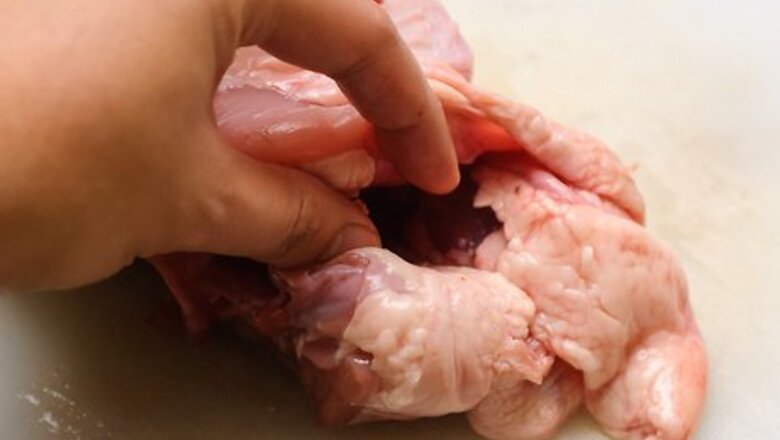
views
Prepping the Turkey
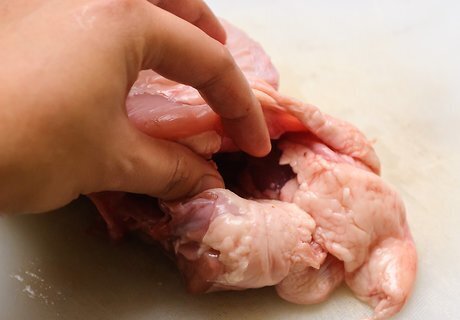
Remove any organs that may be in the turkey's cavity. If you’re buying a prepackaged turkey, there's a good chance that your turkey contains a few extra organs (or giblets), such as the kidney, liver, heart, and gizzard, in the cavity of the turkey. Remove these and set them aside. Sometimes, the giblet pouch is in the neck cavity instead of the main body cavity. You may also find the neck in 1 of these cavities. A good idea for the giblets is to incorporate them into your stuffing recipe. Sauté them in a bit of butter or oil and add them sparingly to most stuffing recipes for added flavor. Many people choose to make broth or stock from the innards of the turkey. Cut them up, along with a diced onion, a couple carrots, as well as a couple stalks of celery, and add them to a pot of boiling water. Add a bit of salt, peppercorns, and several bay leaves to the pot and boil for several hours, skimming the foam off the top every so often.
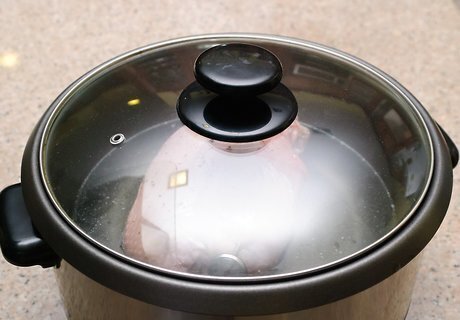
Decide whether to brine the turkey (optional). A brine is a bath of flavored salt water that you soak your bird in for 24 hours before smoking it. Brining your turkey will add extra flavor and help it stay moist during the cooking process. Here is a basic brine recipe you can try for your turkey: Warning: To avoid splashing harmful germs around your kitchen, don’t rinse a raw turkey unless it’s brined. To rinse the brined turkey safely, put it in a clean sink and cover the area around the sink with paper towels. Carefully rinse the turkey cavity under cool, running water, and wash the sink and surrounding area with soap and hot water when you’re done. Bring 2 gallons (7.6 L) of water to a boil in a large saucepan. To it, add 4 cups (1 kg) of salt, 4 cups (800 g) of sugar, 1 bulb of garlic (cut in half), 1 cup (192 g) of black peppercorns, and your choice of fresh herbs (thyme, rosemary, lavender, sage, and marjoram all work well). Turn off the heat and allow the salt and sugar to dissolve completely. Let the mixture steep for 5 minutes. Add the basic brine to a large cooler filled with 3 bags of ice and stir it. To the cooler, add 1 gallon (3.8 L) of apple cider, and 4 each of lemons and oranges, sliced in half. Submerge your turkey in the cooler, making sure it is entirely covered with liquid. Let your bird soak for at least 24 hours, turning the turkey every 6 to 12 hours. Try to keep the cooler in a cold place; if the temperature of the brine goes above 40 °F (4 °C), add extra ice to keep the solution cool and prevent the growth of bacteria. Be sure to rinse your turkey after brining it, otherwise the meat may be saltier than you would like.
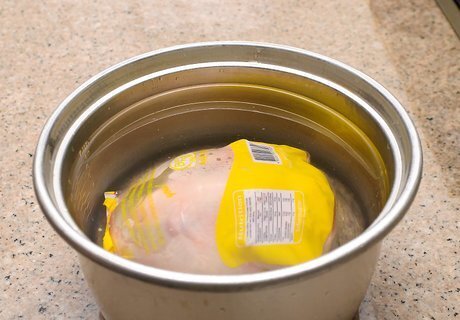
Thaw your turkey completely if it’s frozen. If you chose not to brine your turkey and you purchased a frozen one, you'll want to thaw it completely before smoking it. Thawing a turkey in the refrigerator takes longest but is the safest method for completing the task. Place the turkey in a large bowl or pan and let it sit in the refrigerator for 1 day for every 5 pounds (2.3 kg) of bird. You can also thaw a turkey by covering it in cool water. Submerge the wrapped turkey in a sink full of cold water. It will need to stay in its cold water bath for 30 minutes for every 1 pound (0.45 kg) of bird.
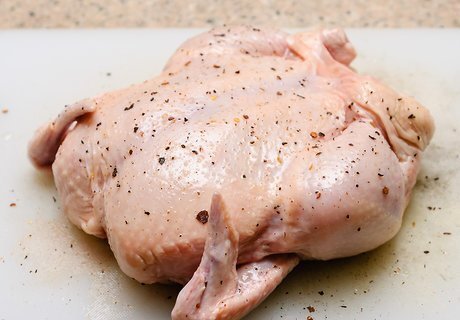
Cover the thawed bird with a rub, a glaze, or basic seasoning. If you chose not to brine the turkey, you can add flavor by putting some seasoning on its skin. Rub a generous amount of oil or butter over the entire bird. Sprinkle it with salt, pepper, and any other desired seasoning. Get creative! A dry rub is a combination of dry spices that you rub into the skin of the turkey, coating it in flavor. For a basic but classic holiday rub, try a combination of kosher salt, pepper, dried thyme, dried rosemary, dried sage, and garlic powder. A glaze is a thick, usually syrupy mixture that is brushed onto meat and which reduces once cooked, concentrating its flavors. Consider going with this holiday-themed glaze consisting of cranberry juice, maple syrup, apple cider, and brown sugar. Who says smoking a turkey needs to be fancy? Give basic seasoning a try. Coat the turkey liberally with oil or softened butter and rub salt and pepper over its skin. You're ready to cook. Feel free to use a barbecue rub that's similar to what you'd use on pork.
Smoking the Turkey

Pre-cook your turkey (optional). Of course, if you have plenty of time on your hands and don't need to speed up the process, you won't need to pre-cook your bird. But if you happen to be in a hurry and want to expedite the cooking process, consider pre-cooking the turkey and blasting it with smoke afterwards. To pre-cook your bird, place it in an oven-safe pan and cover it with foil or a lid. Bake the turkey for 30 minutes at 350 °F (177 °C).
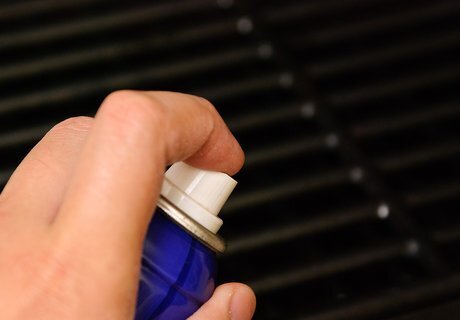
Prepare the grill rack of the smoker. Oil the rungs of the rack or line it with foil to keep the bird from sticking.
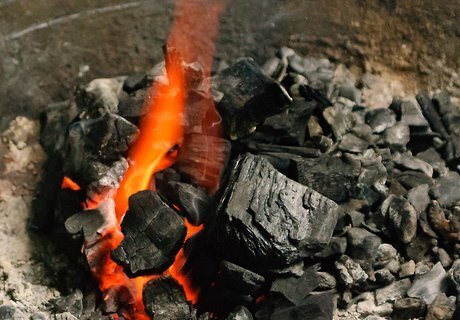
Light your smoker. Your optimum temperature for smoking a turkey is around 230 °F (110 °C), but anywhere between 220 and 240 °F (104 and 116 °C) is acceptable. It will take your smoker about 45 minutes to reach this temperature.

Add your wood. Once the smoker is lit and pre-heated to be ready for cooking, add your pre-soaked wood chips to the smoker. If you want, you can get fancy with your soaking liquids. Say, for example, you're using hickory chips to smoke the turkey. Why not reach for bourbon as your soaking liquid? Or say you're smoking with applewood chips. Why not use apple cider? Complement the flavor of the chips with a tasty soaking liquid. Experiment with different wood chips to alter the flavor of the meat. Milder flavors of wood chips include alder, apple, cherry, grape, maple, mulberry, orange, and peach; stronger flavors include hickory, mesquite, oak, pecan, walnut, and whiskey barrel. Some people prefer not soaking their wood chips—or wood chunks—at all. They argue that wood needs to dry out before it produces smoke, prolonging the process. Experiment for yourself whether smoking with soaked or dry wood chips produces better flavor.
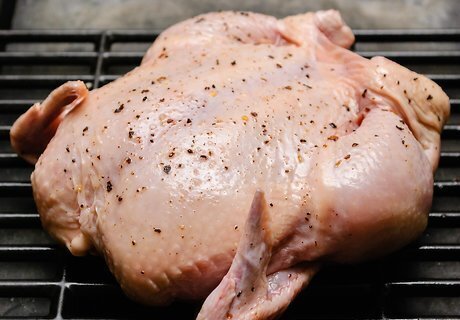
Place the turkey on the smoker. Place the turkey on the cooking rack of the smoker with the breast up. The best part of the rack to place the turkey will depend on where the most direct heat is. You'll want to place the turkey on the side of the rack away from direct heat. Put the lid back on the smoker. Consider placing a drip pan underneath the turkey. If you want to save fluids and fat for some smoky gravy, place a drip pan underneath your rack to catch any fluids leaving your turkey.

Maintain the heat of the smoker at around 230 °F (110 °C). Check the smoker every hour or so to maintain the heat and smoke. Add more charcoal, wood chips, or water as needed. If your smoker doesn't have a thermometer attached to it, consider placing a metal thermometer inside the cooking rack to gauge the temp when you open it.

Time the cooking of your turkey by the weight of the bird. Your turkey will need 30 to 40 minutes per 1 pound (0.45 kg) to smoke. The time difference is determined by your smoker and the temperature outside. For example, at 220 °F (104 °C), a 15 lb (6.8 kg) turkey will take between 8 and 9 hours to smoke. If you decide to cook the turkey at a higher temperature, the cooking time will diminish significantly, but the turkey won't retain as much smoky flavor. At 325 °F (163 °C), a 15 lb (6.8 kg) turkey will take between 3 and 3.5 hours to smoke.
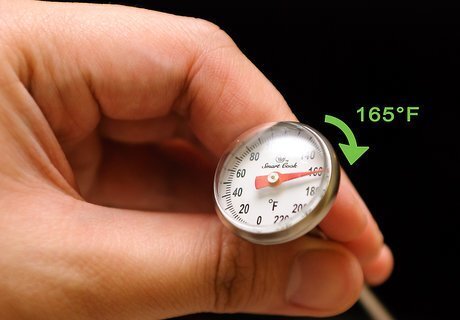
Wait for the internal temperature of the turkey to reach 165 °F (74 °C) for doneness. Calculate the minimum time suggested that the turkey might take to smoke completely. When that amount of time has passed, open the lid and quickly get a reading with your meat thermometer in the thickest part of the thigh area of the bird. The turkey is done when the temperature is at 165 °F (74 °C). If the turkey is not done yet, put the lid back on the smoker and let the bird cook another 30-45 minutes. Then, check for the desired temperature again.
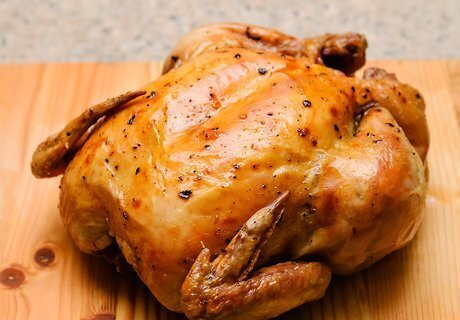
Let it rest. After removing the bird from the smoker, let it rest for around 30 minutes before carving it. This will help the juices settle in the bird, making for a moister treat when you finally do cut into it. Enjoy your smoked turkey on its own, or with a magnificent Thanksgiving fare that includes candied yams, mashed potatoes, green beans, stuffing, and cranberry sauce.




















Comments
0 comment